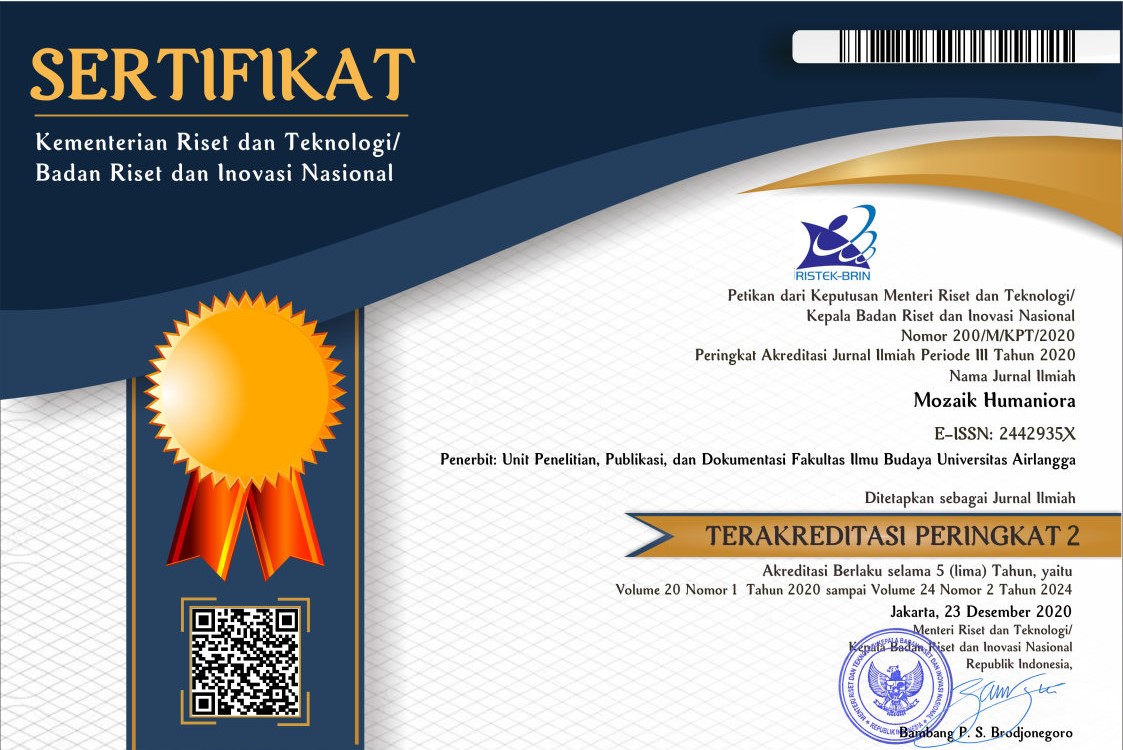Recounting Traumatic Events: Pragmatic and Multimodal Discourse Analysis in Audrie and Daisy (Pengisahan Kejadian Traumatis: Analisis Wacana Multimodal dan Pragmatik dalam Audrie dan Daisy)
Downloads
Abstrak
Film sebagai wacana sinematik dapat menjadi media untuk membahas hasil kerja sistem linguistik, fitur audio-visual, dan efek visual lainnya dengan menggunakan pendekatan pragmatik. Makalah ini bertujuan menganalisis wacana sinematik sebuah film dokumenter berjudul Audrie and Daisy, yang menggambarkan kronologi perundungan dan kekerasan seksual yang dialami oleh dua siswi sekolah menengah bernama Audrie dan Daisy, dengan menggunakan pendekatan pragmatik. Makalah ini menjelaskan bagaimana sistem linguistik yang berkaitan dengan penggunaan bahasa pada wawancara dan investigasi, sinematografi, dan mise-en-scene pada film berhubungan satu dengan yang lain sehingga menjadikan pesan dan isi cerita menjadi bermakna. Penelitian ini menggunakan metode penelitian kualitatif untuk mendapatkan gambaran dan pemahaman mengenai unsur-unsur penting dalam film. Tujuan dari penelitian ini tidak hanya untuk menunjukkan fitur-fitur wacana sinematik tetapi juga untuk menjelaskan makna tersirat dari fitur-fitur tersebut dalam film dan menganalisis tata organisasi film. Dalam pendekatan pragmatik dan wacana sinematik, gagasan mengenai verbal (suara diegetik) dan non-verbal (suara non-diegetik) berkaitan dengan multimodalitas film yang menjadikan pesan menjadi bermakna. Selain itu, hasil penelitian memperlihatkan bahwa film ini menggunakan pendekatan monochronicity untuk menyusun dokumen sinematografi.
Kata kunci: Audrie and Daisy, analisis wacana multimodal, sistem linguistik, fitur audio visual, monochronocity
Abstract
A movie as a cinematic discourse can be a medium for examining the work of linguistic system, audio-visual features, and other visual effects by using the pragmatic approach. This paper aims to analyze the pragmatic and cinematic discourse in a documentary movie Audrie and Daisy, which portrays the chronology of bullying and sexual assault experienced by high school students, Audrie and Daisy. This paper describes how the linguistic systems which are related to the language used in the interview and investigation, the cinematography, and mise-en-scene of the movie can link to one another to make the message and the content of the story meaningful. This study employs a qualitative research method to gain insight and understanding of the significant elements of the movie. The purpose of this research is not only to point out the features of cinematic discourse but also to explain the meaning of the features in the movie and analyze the organization of this movie. Within the framework of pragmatic and cinematic discourse, the notion of verbal (diegetic sound) and non-verbal (non-diegetic sound) are connected to the multimodality of the movie to make a message purposeful. The documentary also utilizes the monochronicity approach to compose the cinematography document.
Keywords: Audrie and Daisy, multimodal discourse analysis, linguistic system, audio-visual features, monochronicity
A., John, Bateman, and Karl-Heinrich Schmidt. 2012. Multimodal film analysis how films mean. New York: Routledge.
Bordwell, David, and Kristin Thompson. 2013. Film art an introduction. New York: The MCGraw-Hill Companies, Inc.
Chepinchikj, Neda, and Celia Thompson. 2016. "Analysing Q2 cinematic discourseusingconversationanalysis." Elsevier 1-14.
Janney, Richard. 2012. "Pragmatics and Cinematic Discourse." Lodz Paper in Pragmatics 6-29.
Johnson, Susan L. 2015. "Workplace bullying prevention: a critical discourse analysis." John Wiley & Sons Ltd 1-9.
Kowalski, Robin M., Gary W. Giumetti, Amber N. Schroeder, and and Micah R. Lattanner. 2014. "Bullying in the digital age: a critical review and meta-analysis of cyberbullying research among youth." Psychological bulletin 1-66.
Malinowski, Bronislaw. 1923. The problem of meaning in primitive languages. London: K. Paul, Trend, Trubner.
McCarthy, Martina Maria. 2014. "Pragmatic analysis of a scene from the Irish movie 'The Snapper'." MA Applied Linguistics 1-16.
Mubenga, Kajingulu Somwe. 2009. "Towards a multimodal pragmatic analysis of film discourse in audiovisual translation." Meta: Translator's Journal 466-484.
Osvaldsson, Karin. 2011. "Bullying in context: Stories of bullying on an internet discussion board." CHILDREN & SOCIETY 317-327.
Paltridge, Brian. 2012. Discourse analysis. London: Bloomsbury Academic.
Pannoni, Alexandra. 2016. "How high school educators should adress traumatic events in class." US News, June 20.
Rawlings, Victoria. 2016. "Bullying linked to gender and sexuality often goes unchecked in schools." The Conversation, March 3.
Rogers, Ariel. 2013. Cinematic appeals: the experience of new movie technologies. New York: Columbia University Press.
Rogers, Ariel. 2013. Cinematic appeals: the experience of new movie technologies. New York: Columbia University Press.

Mozaik Humaniora is licensed under a Creative Commons Attribution-ShareAlike 4.0 International License. Both authors and Mozaik Humaniora agree with the following attribution of journal:
1. Copyright of this journal is possession of Author, by the knowledge of the Editorial Board and Journal Manager, while the moral right of the publication belongs to the author.
2. The journal allows the author(s) to retain publishing rights without restrictions
3. The legal formal aspect of journal publication accessibility refers to Creative Commons Attribution Share-Alike (CC BY-SA).
4. The Creative Commons Attribution Share-Alike (CC BY-SA) license allows re-distribution and re-use of a licensed work on the conditions that the creator is appropriately credited and that any derivative work is made available under "the same, similar or a compatible license”. Other than the conditions mentioned above, the editorial board is not responsible for copyright violation.


















